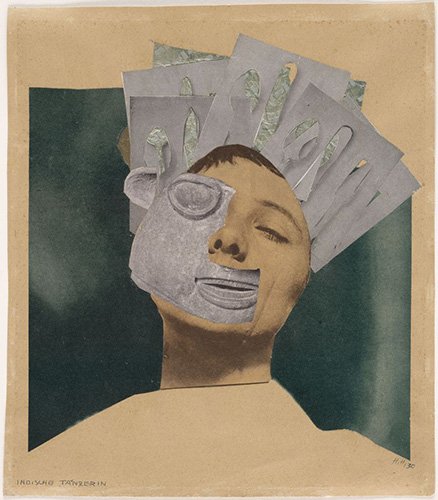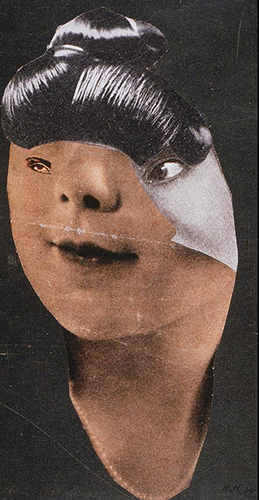
Indian Dancer, 1930. Hannah Hoch.
Editor’s Note: This feature was originally published on our previous platform, In the In-Between: Journal of Digital Imaging Artists, and the formatting has not been optimized for the new website.
Hannah Hoch (born Anna Therese Johanne Hoch on November 1, 1899) remains a well-known member of the Berlin Dada movement, and was among the first prominent artists to work with photo-montage techniques. Hoch attended the College of Arts and Crafts in Berlin from 1912 to 1914, during the tense lead-up to the first World War.
Hoch later described the war as having shattered her view of the world and affording her a newly political consciousness. Hoch initially became involved with Dada around 1919, as a result of her relationship with fellow Dadaist Raoul Hausmann. It was through Hausmann that Hoch was introduced to several other influential artists of the Dada movement, among them Kurt Schwitters, Hans Richter, and Piet Mondrian. Hoch’s work, while mostly in keeping with the general Dadaist aesthetic, skillfully added a wryly feminist note to the movement’s philosophy of disgust with the perceived wrongs of society.
_______________________________________________________________________________

Da-Dandy, 1919. Hannah Hoch.
______________________________________________________
The Dadaists insisted that the valuing of “logic” among modern cultures had led to an over-valuing of conformity, classism, and nationalism which in turn provided a suitable environment for the horrors of World War I. Dadaists therefore rejected this devotion to reason in favor of chaos, nonsense, and irrationality. Through her art, Hoch quietly submitted female equality to the list of anti-bourgeois and radically leftist sentiments which Dada espoused.
Unfortunately Hoch remained alone in her attempts to convey this message, and remained the only female Berlin Dadaist, never fully accepted by the rest of the group. Hans Richter patronizingly dismissed her contribution to the movement by calling it merely “the sandwiches, beer and coffee she managed somehow to conjure up despite the shortage of money,” failing to note that Hoch was among the few members of her immediate artistic circle with a reliable income. She herself wrote:
“None of these men were satisfied with just an ordinary woman. But neither were they included to abandon the (conventional) male/masculine morality toward the woman. Enlightened by Freud, in protest against the older generation. . . they all desired this ‘New Woman’ and her groundbreaking will to freedom. But—they more or less brutally rejected the notion that they, too, had to adopt new attitudes. . . This led to these truly Strinbergian dramas that typified the private lives of these men.”
– From undated notes among Hoch’s possessions
___________________________________________

Cut with the Kitchen Knife Dada through the Last Weimar Beer-Belly Cultural Epoch of Germany, 1919. Hannah Hoch.
______________________________________________________________________
In addition to her Dadaist influences, Hoch’s employment also contributed to her artistic style. She spent many years employed by Ullstein Verlag (The Ullstein Press) designing fashion and embroidery patterns for women’s magazines. Her experience working in textiles led to the development of less Dada-like and more abstract pieces such as Tailor’s Flower (1920) as well as a great deal of her later work. Hoch’s most famous piece, Cut with the Kitchen Knife Dada through the Last Weimar Beer-Belly Cultural epoch of Germany (1919) remains a powerful example of the ironically insensible cultural critique which embodied Dada, yet still shows Hoch’s distinct style.
___________________________________________________________

German Girl, 1930. Hannah Hoch.
_______________________________________________________________
One of Hoch’s most often used techniques was the fusion of male and female bodies, or the bodies of “traditional” German women with more recent depictions of a sexually liberated “modern” German woman. Her work prods at notions of women’s objectification, sexuality, and humanity by depicting the as vibrant central characters, often the only ones in motion; and reducing men to individual parts, often attached to larger female forms. Possibly Hoch’s most ambitions collection of work, From An Ethnographic Museum (1929), is a bold statement about racial, gender, and cultural equality told exclusively through depictions of women’s bodies contrasted with images from a museum catalogue. One of the more striking pieces, Indian Dancer (1930) is an incisive remark about women’s labor which combines the head of a famous actress with a tribal mask, adorned with a crown of kitchen utensils.
_______________________________________________________________

Dompteuse (Tamer), 1930. Hannah Hoch.
_________________________________________________________
Through her refined sense of color, remarkably timeless stylistic appeal, and deceptively simple compositions, Hannah Hoch established herself as a serious contributor to the artist world of early 20th century Europe, and proved herself to be the type of woman she clearly admired. While the causes she championed remain embattled, they are also extremely relevant, and her voice is no longer the only cry to rise up against traditional sensibilities surrounding race, gender, and human rights.
_________________________________________________________

Tailors Flower, 1919. Hannah Hoch.
______________________________________________________

From An Ethnographic Museum, 1929. Hannah Hoch.
___________________________________________________
-
Lager, Liz. “Hannah Höch: The “Quiet Girl” with a Big Voice (Part I).” Venetian Red. http://venetianred.net/
2010/01/16/hannah-hoch-the- good-girl-with-big-scissors- part-i/ -
Sante, Luc. “Dada’s Girl: Hannah Hoch Thumbs Her Nose At Art.” Slate Magazine. http://www.slate.
com/articles/arts/art/1997/04/ dadas_girl.html -
“Hannah Hoch.” Dadandy. http://www.
dadadandy.com/DADADANDY- HannahHoch.html
Images via:
-
Cut With A Kitchen Knife…”: http://artforus.
wordpress.com/2012/11/27/cut- with-a-kitchen-knife/ -
Tailor’s Flower, Da-Dandy, Dompteuse (Tamer) : http://venetianred.net/2010/
01/16/hannah-hoch-the-good- girl-with-big-scissors-part-i/ -
From An Ethnographic Museum, German Girl : http://www.studyblue.com/
notes/note/n/art-history-test- 2/deck/1403245 -
Indian Dancer: http://www.
cavetocanvas.com/post/ 44103335601/hannah-hoch- indian-dancer-from-an- ethnographic
Written by Meghan Maloney.
___________________________
Stay connected with In the In-Between
